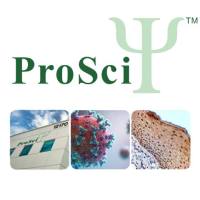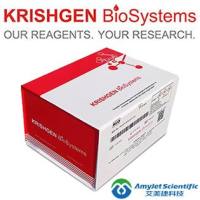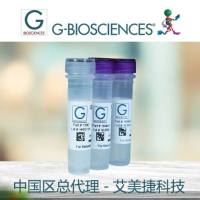Characterization of Chemokine Receptors
互联网
- Abstract
- Table of Contents
- Materials
- Figures
- Literature Cited
Abstract
This unit describes the procedures for measuring binding of a radiolabeled chemokine to chemokine receptors in cells or cell membranes. The whole?cell binding assay can be used for both purified leukocytes as well as transfected cell lines expressing chemokine receptors. Two basic protocols are described. The first is applicable to all cells expressing chemokine receptors, both primary cultures as well as recombinantly transfected cell lines expressing a single chemokine receptor. The second is used principally for transfected cell lines and measures chemokine binding to cell membranes using scintillation proximity assay (SPA) methodology, but does not require washing steps and thus is applicable to automated high?throughput screening strategies. An alternative procedure is also described which also uses SPA methodology to measure GTP?gamma?S binding to chemokine receptors in cell membranes. The two basic protocols can be used to determine the binding of compounds to chemokine receptors, while the alternate protocol determines the effects of compounds on the chemokine?stimulated activation of the receptor.
Table of Contents
- Basic Protocol 1: Binding of Radiolabeled Chemokines to Cells Expressing Chemokine Receptors
- Basic Protocol 2: Competition Equilibrium Assay Using Scintillation Proximity Assay (SPA) Technology on Membranes Expressing a Chemokine Receptor
- Alternate Protocol 1: SPA‐Based [35S]GTPγS Binding to Cell Membranes Expressing Chemokine Receptors
- Reagents and Solutions
- Commentary
- Literature Cited
- Figures
- Tables
Materials
Basic Protocol 1: Binding of Radiolabeled Chemokines to Cells Expressing Chemokine Receptors
Materials
Basic Protocol 2: Competition Equilibrium Assay Using Scintillation Proximity Assay (SPA) Technology on Membranes Expressing a Chemokine Receptor
Materials
Alternate Protocol 1: SPA‐Based [35S]GTPγS Binding to Cell Membranes Expressing Chemokine Receptors
|
Figures
-
Figure 1.24.1 Equilibrium binding competition assay of TARC binding to mCCR4 expressed in HEK cells using a whole‐cell assay. The competition is homologous in that the radiolabeled and unlabeled ligand are both human TARC, which is species cross‐reactive such that it also binds to the murine CCR4 receptor. The IC50 value obtained in this experiment is 0.9 nM. View Image -
Figure 1.24.2 Heterologous equilibrium competition binding assays of mCCR5 expressed in Chinese hamster ovary (CHO) cells using a whole cell assay. Human [125 I]MIP‐1α was used as the tracer, and the competition was determined for mMIP‐1α (solid triangles), RANTES (open squares), and two amino terminally‐modified hRANTES proteins—i.e., Met‐RANTES (open circles) and AOP‐RANTES (solid circles; Proudfoot et al., ; Simmons et al., ). In this assay, mMIP‐1α and hRANTES had IC50 values of 0.04 and 9.7 nM, respectively. AOP‐RANTES had a slightly higher affinity with an IC50 of 3.7 nM, while Met‐RANTES had a significantly lower affinity with an IC50 of 170 nM. View Image -
Figure 1.24.3 Competition binding experiment with RANTES (solid circles) and MIP‐1α (open circles) on membranes prepared from CHO cells stably transfected with hCCR5. The CCR5 cell membranes were incubated for 3 hr at room temperature with 0.2 nM [125 I]MIP‐1α and increasing concentrations of RANTES and MIP‐1α.The IC50 values determined in this assay for RANTES and MIP‐1α were 2.7 nM and 0.7 nM, respectively. View Image -
Figure 1.24.4 ANTES (open circles) and MIP‐1α (filled circles) stimulate CCR5‐mediated [35 S]GTPγS binding to CHO cell membranes. CCR5 cell membranes were incubated for 30 min in the presence of increasing concentrations of RANTES or MIP‐1α. In this assay, RANTES had an EC50 value of 12 nM and MIP‐1α had an EC50 value of 760 nM. View Image -
Figure 1.24.5 Stimulation of [35 S]GTPγS binding to CCR5 cell membranes by RANTES (solid bar) and AOP‐RANTES (hashed bar). CCR5 cell membranes were incubated for 30 min in the absence (basal; open bar) or presence of 1 µM RANTES or 0.1 µM AOP‐RANTES; n = 3. This experiment confirms the fact that AOP‐RANTES is a full agonist of CCR5, and as was reported for phosphorylation of the receptor, is even more potent than RANTES in certain assays (Oppermann et al., ). View Image
Videos
Literature Cited
| Literature Cited | |
| Elsner, J., Mack, M., Brühl, H., Dulkys, Y., Kimmig, D., Simmons, G., Clapham, P.R., Schlöndorff, D., Kapp, A., Wells, T.N.C., and Proudfoot, A.E.I. 2000. Differential activation of CC chemokine receptors by AOP‐RANTES. J. Biol. Chem. 275:7787‐7794. | |
| Gerard, C. 1999. Chemokine receptors and ligand specificity: Understanding the enigma. In Chemokines and Cancer (B.J. Rollins, ed.) pp. 21‐31. Humana, Totowa, NJ. | |
| Hoogewerf, A.J., Kuschert, G.S., Proudfoot, A.E.I., Borlat, F., Clark, L.I., Power, C.A., and Wells, T.N.C. 1997. Glycosaminoglycans mediate cell surface oligomerization of chemokines. Biochemistry 36:13570‐13578. | |
| Imai, T., Baba, M., Nishimura, M., Kakizaki, M., Takagi, S., and Yoshie, O. 1997. The T cell‐directed CC chemokine TARC is a highly specific biological ligand for CC chemokine receptor 4. J. Biol. Chem. 272:15036‐15042. | |
| Kledal, T.N., Rosenkilde, M.M., and Schwartz, T.W. 1998. Selective recognition of the membrane‐bound CX3C chemokine, fractalkine, by the human cytomegalovirus‐encoded broad‐spectrum receptor US28. FEBS Lett. 441:209‐214. | |
| Luster, A.D. 1998. Chemokines: Chemotactic cytokines that mediate inflammation. N. Engl. J. Med. 338:436‐445. | |
| Neote, K., DiGregorio, D., Mak, J.Y., Horuk, R., and Schall, T.J. 1993. Molecular cloning, functional expression, and signaling characteristics of a C‐C chemokine receptor. Cell. 72:415‐425. | |
| Oppermann, M., Mack, M., Proudfoot, A.E., and Olbrich, H. 1999. Differential effects of CC chemokines on CC chemokine receptor 5 (CCR5) phosphorylation and identification of phosphorylation sites on the CCR5 carboxyl terminus. J. Biol. Chem. 274:8875‐8885. | |
| Ponath, P.D. 1998. Chemokine receptor antagonists: Novel therapeutics for inflammation and AIDS. Exp. Opin. Invest. Drugs 7:1‐18. | |
| Power, C.A., Meyer, A., Nemeth, K., Bacon, K.B., Hoogewerf, A.K., Proudfoot, A.E.I., and Wells, T.N.C. 1995. Molecular cloning and functional expression of a novel CC chemokine receptor cDNA from a human basophilic cell line. J. Biol. Chem. 270:19495‐19500. | |
| Proudfoot, A.E.I. and Power, C.A. 2001. The chemokine system: novel broad‐spectrum therapeutics targets. Curr. Opin. Pharm. 1:417‐424. | |
| Proudfoot, A.E.I., Power, C.A., Hoogewerf, A.J., Montjovent, M.O., Borlat, F., Offord, R.E., and Wells, T.N.C. 1996. Extension of recombinant human RANTES by the retention of the initiating methionine produces a potent antagonist. J. Biol. Chem. 271:2599‐2603. | |
| Proudfoot, A.E., Wells, T.N., and Clapham, P.R. 1999. Chemokine receptors: Future therapeutic targets for HIV? Biochem. Pharmacol. 57:451‐463. | |
| Rollins, B.J. 1997. Chemokines. Blood 90:909‐928. | |
| Schwarz, M.K. and Wells, T.N.C. 1999. Recent developments in modulating chemokine networks. Exp. Opin. Ther. Patents 9:1471‐1490. | |
| Simmons, G., Clapham, P.R., Picard, L., Offord, R.E., Rosenkilde, M.M., Schwartz, T.W., Buser, R., Wells, T.N.C. and Proudfoot, A.E. 1997. Potent inhibition of HIV‐1 infectivity in macrophages and lymphocytes by a novel CCR5 antagonist. Science 276:276‐279. | |
| Trkola, A., Gordon, C., Matthews, J., Maxwell, E., Ketas, T., Czaplewski, L., Proudfoot, A.E., and Moore, J.P. 1999. The CC‐chemokine RANTES increases the attachment of human immunodeficiency virus type 1 to target cells via glycosaminoglycans and also activates a signal transduction pathway that enhances viral infectivity. J. Virol. 73:6370‐6379. | |
| Wells, T.N.C., Power, C.A. and Proudfoot, A.E.I. 1998. Definition, function and pathophysiological significance of chemokine receptors. Trends Pharmacol. Sci. 19:376‐380. | |
| Weng, Y.M., Siciliano, S.J., Waldburger, K.E., Sirotinameisher, A., Staruch, M.J.D., Gould, S.L., Daugherty, B.L., Springer, M.S., and DeMartino, J.A. 1998. Binding and functional properties of recombinant and endogenous CXCR3 chemokine receptors. J. Biol. Chem. 273:18288‐18291. |







